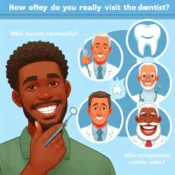
😁🦷 Braces at Any Age? Here’s What You Need to Know Before Starting Orthodontic Treatment
When you think of braces, the image of a teenager with a metal smile might come to mind. But the truth is—braces aren’t just for kids anymore! Whether you’re 12, 25, or even 55, orthodontic treatment can help align your teeth and give you a healthier, more confident smile.
So, can you get braces at any age? Yes, you absolutely can. Orthodontic advancements have made it easier and more accessible for both children and adults to start their journey toward straighter teeth and better oral health.
In this guide, we’ll explore:
-
Why age is not a barrier
-
The benefits of getting braces at different life stages
-
Types of braces available
-
What to expect during treatment
-
Common FAQs
👶👩👴 Is There an Ideal Age for Braces?
Orthodontic treatment is most effective during childhood and teenage years when the jaw and teeth are still developing. However, there is no upper age limit for getting braces.
✅ Children (Ages 7–12):
-
Early signs of misalignment can be detected
-
Preventive or interceptive orthodontics may be recommended
-
Early intervention may reduce the need for complex treatment later
✅ Teenagers (Ages 13–19):
-
Most common age group for braces
-
Jaw growth can be guided effectively
-
Fast results and strong compliance
✅ Adults (20+):
-
Braces are just as effective
-
Cosmetic and health benefits
-
Ideal for those who missed treatment as teens
-
Often paired with cosmetic treatments or jaw correction
🧑⚕️ Orthodontists today treat more adults than ever before. It’s never too late to get the smile you deserve.
🌟 Benefits of Getting Braces at Any Age
Whether you’re in school, college, working, or retired—braces can transform your smile and oral health.
🦷 1. Improved Appearance & Confidence
A straighter smile boosts self-esteem, especially in professional or social settings.
🧠 2. Better Oral Health
Aligned teeth are easier to clean and less prone to cavities, plaque, and gum disease.
🗣️ 3. Improved Bite & Speech
Corrects overbite, underbite, or crossbite that may affect chewing and speaking.
😬 4. Reduced Risk of Jaw Problems
Braces relieve pressure on the jaw joint and reduce the chance of TMJ disorders.
💸 5. Long-Term Savings
Early or timely treatment helps avoid costlier dental issues like root canals, implants, or gum surgery later.
🛠️ Types of Braces Available
Thanks to modern advancements, you don’t have to worry about bulky metal braces unless you choose them!
🔩 1. Metal Braces (Traditional)
✅ Most affordable
✅ Highly effective for all cases
✅ Visible brackets and wires
⚪ 2. Ceramic Braces
✅ Tooth-colored brackets blend in
✅ Less noticeable
✅ Slightly more expensive than metal braces
😁 3. Clear Aligners
✅ Removable and invisible
✅ Ideal for adults and teens
✅ Requires discipline and consistency
🔙 4. Lingual Braces
✅ Hidden behind the teeth
✅ No one can see them
✅ Technically complex and costly
🧑⚕️ An orthodontist will recommend the best type based on your age, bite, budget, and lifestyle.
🕒 What to Expect During Treatment
Braces work by applying gentle pressure over time to move teeth into the desired position.
⏳ Duration:
-
Children: 12–18 months
-
Teens: 12–24 months
-
Adults: 18–30 months (sometimes longer due to mature bone density)
🔁 Regular Adjustments:
Every 4–6 weeks, you’ll need check-ups for adjustments, monitoring, and progress.
💡 Age Doesn’t Matter, But These Things Do:
✅ Gum health: Healthy gums and bones are essential at any age
✅ Dental hygiene: Braces require extra oral care to prevent cavities and plaque
✅ Commitment: Adult treatment may take longer due to less bone flexibility
✅ Realistic expectations: Results are amazing, but patience is key
📌 Braces at Different Life Stages: Pros & Considerations
| Age Group | Pros | Considerations |
|---|---|---|
| Children | Easy to guide growth | Needs parental supervision |
| Teens | Fast jaw movement | Appearance may cause self-consciousness |
| Adults | High motivation, cosmetic benefit | May take longer, costlier |
🙋♀️ FAQs – Braces at Any Age
❓ Can adults over 40 get braces?
Absolutely! As long as your gums and bones are healthy, age is not a barrier.
❓ Will braces work slower for adults?
Slightly, because adult bone tissue is denser. But results are still excellent.
❓ Are clear aligners better for adults?
Many adults prefer aligners for aesthetics and comfort, but not all cases qualify. Complex misalignments may still require traditional braces.
❓ Are braces painful?
You may feel discomfort for a few days after adjustments, but braces are not painful.
❓ Is orthodontic treatment expensive?
Costs vary by location, type of braces, and treatment complexity. Many dental clinics offer EMI or flexible payment plans.
💰 Average price range (USD):
-
Metal braces: $3,000 – $7,000
-
Ceramic braces: $4,000 – $8,000
-
Clear aligners: $4,000 – $9,000
-
Lingual braces: $8,000 – $10,000+
🌟 Final Thoughts: It’s Never Too Late for a Better Smile
Age is just a number when it comes to straightening your teeth. Whether you’re 13 or 53, orthodontic treatment offers life-changing benefits that go beyond looks. It’s about comfort, confidence, and long-term oral health.
👉 Schedule a consultation with a qualified orthodontist to see what type of braces or aligners would suit your needs best—because the best time to start your smile transformation is now.
🦷 Braces don’t care how old you are. Your dream smile is still possible. Start your journey today! 😁🛠️
Recent Posts
🥦 Can Diet Affect My Dental Health? Here’s What You Need to Know
🦷🔍 What Are the Signs of Gum Disease?
All Categories
- Anesthesia
- Cosmetic Dentistry
- Health, Wellness and Ergonomics
- Hygiene
- Imaging, CBCT, and Radiography
- Implant Dentistry
- Laser Dentistry
- Marketing
- Oral Pathology, Pharmacology, and Cariology
- Oral Surgery
- Orthodontics
- Paradental and Infection Control
- Prosthodontics
- Public Health
- Research
- Restorative Dentistry
- TMJ and Occlusion


